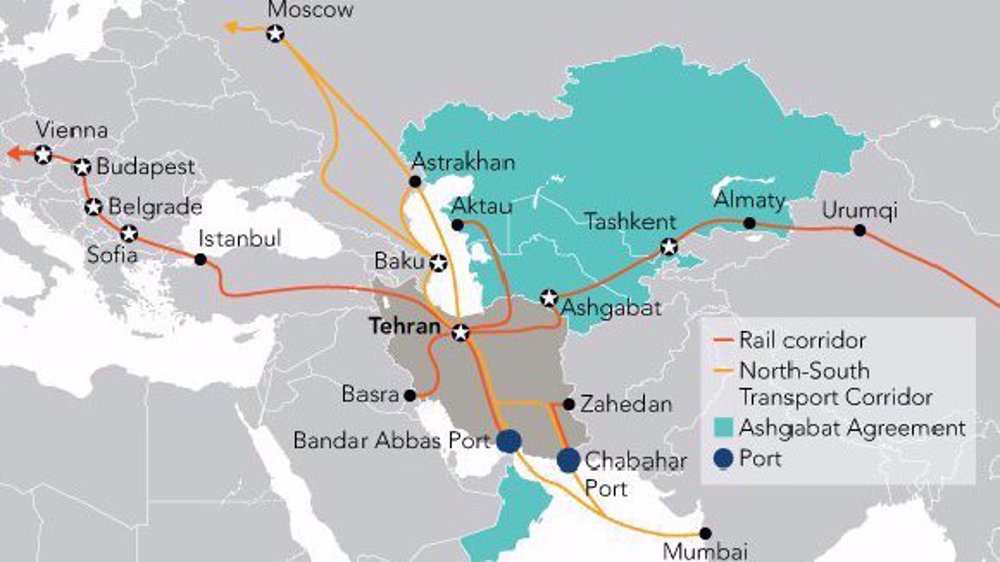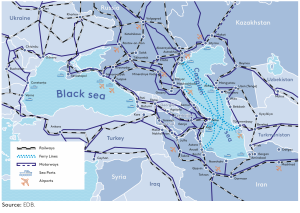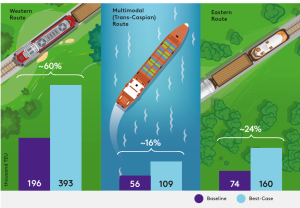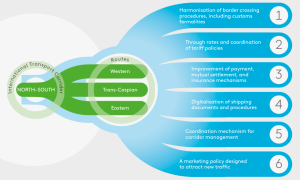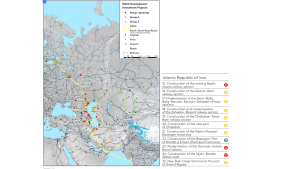International transport corridors (ITCs) are strategic multimodal routes designed to facilitate the efficient movement of goods and passengers across borders. They integrate air, sea, rail, and road transport to create predictable and transparent logistics pathways, enhancing trade connectivity, reducing costs, and fostering economic cooperation among participating nations. ITCs enable seamless transitions between transport modes, optimizing logistics and improving supply chain efficiency. By linking major economic centers, they boost trade volumes and contribute to economic growth. Strategically positioned, many corridors serve as crucial trade links, such as the International North-South Transport Corridor (INSTC), which connects India, Iran, Azerbaijan, and Russia, facilitating trade between South Asia and Europe. Ongoing modernization efforts focus on expanding infrastructure, including railway, port, and road upgrades, to accommodate increasing trade demands.
Examples include the INSTC, a 7,200 km route that cuts shipping times and costs between India and Russia, and the Silk Road Economic Belt, part of China’s Belt and Road Initiative, which strengthens connectivity between China and Europe through Central Asia.
Western-Backed Transport Corridors in Asia: Alternatives to Bypass Russia and Iran in Trade
There are several transport corridors in Asia, but many are more influenced by political decisions and strategic intentions rather than technical and economic feasibility. Key examples include the Trans-Caspian Trade Route (TRACECA), the India-Middle East-Europe Economic Corridor (IMEC), the Iraq-Turkey-Europe Development Road, and the Zangezur Corridor. These projects, largely supported by Western countries, aim to establish alternative routes that bypass Russia and Iran, but their viability remains uncertain due to various geopolitical, economic, and logistical challenges.
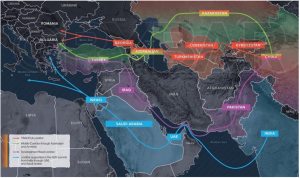
Iraq-Turkey-Europe Development Road: A Project Hindered by Geopolitical Tensions
The Iraq-Turkey-Europe Development Road, with the Grand Faw Port as a key component, aims to establish a strategic trade link connecting the Persian Gulf to Europe through Turkey. This corridor is expected to reduce transit times and generate economic benefits, including the creation of 100,000 jobs and annual revenue of approximately $4 billion for Iraq (Tumanishvili et al., 2018). However, multiple factors undermine the feasibility of the project. Geopolitical instability, Turkish military interventions, and concerns about Turkey’s increasing economic and political influence in Iraq present major challenges (Emerson, 2014). Security risks, unresolved regional conflicts, and economic uncertainties further hinder its prospects. Although the initial estimated cost stood at $17 billion, experts now believe it could exceed $24 billion (Gater-Smith, 2018). Without long-term stability and external financial support, the project’s future remains uncertain.
The India-Middle East-Europe Economic Corridor (IMEC): A Politically Driven Initiative
The India-Middle East-Europe Economic Corridor (IMEC), championed by the United States and the European Union, was introduced as a counterbalance to China’s Belt and Road Initiative (Shlykov, 2023). However, geopolitical events have significantly hindered its progress. The ongoing Israel-Hamas conflict and increased security threats in the Red Sea have cast doubts on the project’s feasibility (Yildirim, 2012). IMEC relies on regional stability, which remains fragile due to strained relations between Israel and its Arab neighbors. Turkey has also opposed IMEC in favor of its Iraq Development Road initiative, further complicating the corridor’s implementation (Keser, 2015). Beyond geopolitical concerns, the economic rationale behind IMEC remains weak. More cost-effective and operationally sound alternatives, such as those utilizing Iranian transit routes, present viable competition, calling IMEC’s long-term sustainability into question (Alshareef, 2023).
The TRACECA Corridor: Strategic Intentions Over Economic Feasibility
The TRACECA corridor, also known as the Trans-Caspian Trade Route, has resurfaced as a focal point for Western-backed infrastructure development. Originally conceptualized in the mid-1990s under the “Storm over the Caspian” initiative, it was designed to create alternative trade routes bypassing Russia. Azerbaijan’s geographical positioning plays a pivotal role in this corridor (Alshareef, 2023; Yildirim, 2012). Permanent representatives in Uzbekistan, Turkmenistan, and Kazakhstan actively promote TRACECA, anticipating significant economic benefits for transit countries (Kaw, 2019; Tumanishvili et al., 2018). However, the corridor faces challenges such as its large scale, the involvement of numerous participants, and the substantial investments required. OECD countries are exploring additional alternative corridors, such as the India-Europe route through the UAE, Saudi Arabia, and Israel, which faces opposition from Turkey (Emerson, 2014; Shlykov, 2023). Another proposed route through Iraq and Turkey faces geopolitical instability in Iraq, hindering its development. The Persian Gulf corridor, despite its strategic advantages, requires multiple transshipments, increasing logistical complexities. However, Gulf nations possess both the financial resources and political stability needed for infrastructure development (Gater-Smith, 2018). Importantly, these Western-backed corridors tend to exclude Central Asian nations from transcontinental trade networks, limiting their economic engagement (Gorshkov & Bagaturia, 2001; Keser, 2015).
The Zangezur Corridor: A Politically Motivated Project
Another politically influenced transport corridor is the Zangezur Corridor, which aims to connect Azerbaijan with its Nakhchivan exclave through Armenia, providing a direct link to Turkey. This project is a key strategic objective for Azerbaijan and Turkey, but it remains heavily contested by Armenia. Given the unresolved territorial disputes and the fragile ceasefire in the region, the feasibility of the corridor remains highly uncertain. Political backing from Turkey and Azerbaijan contrasts with Armenia’s reluctance, making the project’s implementation highly volatile.
In the scope of the last two corridors, Central Asian nations remain cautious about engaging in Western-backed initiatives such as TRACECA due to financial uncertainties and concerns over sovereignty. While China’s “One Belt, One Road” (OBOR) initiative presents opportunities for infrastructure development, it also carries risks, such as increasing debt dependency and strategic overreliance on Chinese investments (Kaw, 2019). The competition among TRACECA, OBOR, and the INSTC underscores the importance of Central Asia’s ability to navigate between different geopolitical and economic influences. A pragmatic approach for Central Asia would be to integrate the INSTC with other trade corridors, allowing for improved connectivity while maintaining economic sovereignty. By leveraging its geographic position and natural resources, Central Asia can enhance its regional standing, attract investment, and develop a more resilient trade network. The future of Eurasian trade corridors will be determined by a delicate balance between competition and cooperation among TRACECA, OBOR, and INSTC, with Central Asia playing a key role in shaping the region’s logistical landscape (Tumanishvili et al., 2018).
International North-South Transport Corridor (INSTC)
The International North-South Transport Corridor (INSTC) is a 7,200-kilometer multimodal trade route connecting India, Iran, Russia, and Europe, designed to reduce transit costs and time compared to traditional routes like the Suez Canal. Established in 2000 by India, Iran, and Russia, it later expanded to include Kazakhstan, Belarus, Azerbaijan, Armenia, Georgia, Turkey, and other nations. Iran’s strategic geographical location, robust infrastructure, and key investments make it a central player in INSTC’s success.
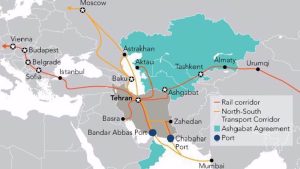
The INSTC is emerging as a key “southern” transport vector in Eurasia’s new logistics landscape, offering advantages such as the shortest route to South Asia, East Africa, and the Middle East, multimodal transport integration, and spare throughput capacity. Successful containerized freight deliveries between Turkey-Russia and Russia-China in 2021-2022 highlight its growing role. The INSTC reduces transit times and costs compared to traditional routes via the Baltic, Azov, and Black Sea. The corridor facilitates the geographical expansion of trade in key directions. An EDB 2021 report projects INSTC freight potential to reach 25-26 million tonnes (240,000-620,000 TEU) by 2030, covering 40% of Russia’s trade with the Global South (Nikolaev et al., 2022). Increased geopolitical interest and new trade flows (e.g., fertilizers, metals, and petroleum) could further boost traffic by 2-4 million tonnes in the short term and up to 5-7 million tonnes within a decade (Nikolaev et al., 2022).
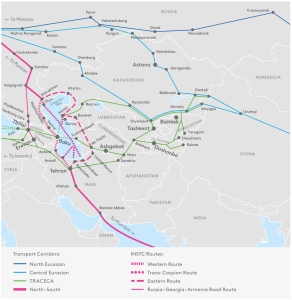
Role of the INSTC in the Eurasian Transport Network
–
INSTC Corridor: Investments and Soft Infrastructure
The International North-South Transport Corridor (INSTC) is a key logistics route within the Eurasian Transport Network, offering the shortest freight transport link between the EAEU, South Asia, East Africa, and the Far East. Post-COVID-19, its significance has grown, with increasing investments and policy initiatives aimed at strengthening trade connectivity. However, the INSTC still faces over 40 physical and administrative barriers, including missing transport links, bottlenecks, and bureaucratic hurdles. Countries such as Turkmenistan, Russia, Iran, and Kazakhstan are actively improving infrastructure, streamlining transit policies, and launching new containerized freight services to overcome these obstacles.
Investment Priorities for INSTC Development
To address the existing challenges, over 100 infrastructure projects have been identified and classified into three priority areas:
- Eliminating Missing Links and Critical Bottlenecks – Enhancing end-to-end international freight operations by filling infrastructure gaps along the corridor’s main sections.
- Improving Operational Efficiency – Upgrading key transport sections and developing alternative routes to increase the corridor’s transport capacity.
- Expanding the Corridor Network – Developing branches and junctions to connect the INSTC to other corridors and routes.
These priorities are visually represented in the following figure:
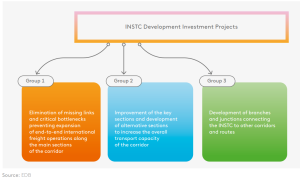
Prioritisation of the INSTC Investment Projects (Vinokurov et al., 2022)
Geographic Structure and Funding of INSTC Investments
The total infrastructure investment for INSTC amounts to $38.2 billion, with the largest share allocated to Russia and Iran for transport modernization. The funding covers 95 major projects, focusing on the modernization of railway networks, road infrastructure, and port expansions to enhance freight movement efficiency. The geographic distribution of these investments is illustrated in the following chart, showing how funds are prioritized among key countries involved in the INSTC development:
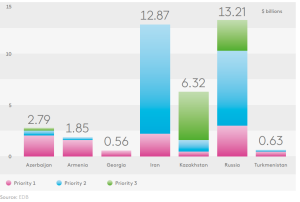
Geographic Structure of INSTC Infrastructure Investment Projects Ranked by Priority (Vinokurov et al., 2022)
–
INSTC: Challenges & Barriers
The challenges that the INSTC faces as it continues to evolve include both non-physical and infrastructural barriers, affecting transport processes, intermodal services, and border crossings (see Figure ). These barriers include uncoordinated transport policies of the member states, international sanctions, the economic crisis, non-harmonised international transport standards and border-crossing procedures, high competition between modes of transport, missing links, and corridor bottlenecks (EDB, 2022, p. 21).
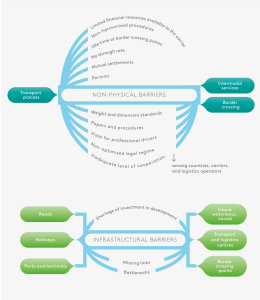
Barriers to the INSTC Development
Non-Physical Barriers
One of the most serious constraints is the sanctions imposed on Iran and companies operating there, along with secondary sanctions affecting third-country businesses involved in joint projects with Iranian firms. These restrictions have a significant impact on INSTC operations, particularly by delaying transport infrastructure development, limiting international shipping access to Iranian ports (except Chabahar, which is financed by India), and complicating financial transactions between stakeholders. Additionally, cargo transported along the corridor faces higher insurance costs, all of which hinder the INSTC’s ability to gain a competitive edge in expanding container transit between India, South Asia, the Persian Gulf, and Europe (EDB, 2022, p. 21).
Additional non-physical barriers slowing down transit operations include:
- Limited financial resources available for the corridor’s expansion and maintenance
- Inefficiencies at border crossing points, leading to delays
- Inconsistent customs rules and tariffs across participating nations
- Lack of standardization in weights, dimensions, and transport policies
- Bureaucratic obstacles in permits and procedures
- Regulatory misalignment among different states
- Lack of professional driver accreditation
- Uncoordinated legal regimes affecting transport governance
- Inadequate supervision among investors, carriers, and logistics operators (EDB, 2022, p. 21)
These factors contribute to higher transit costs, longer transportation times, and reduced efficiency along the corridor.
Infrastructural Barriers
These relate to physical constraints that limit the INSTC’s capacity and operational efficiency, including:
- Insufficient investment in roads, railways, and port infrastructure
- Missing links and bottlenecks along key transport routes
- Limited connectivity with border crossing points and inland waterways
Roads
The incomplete Rasht-Astara railway remains a critical bottleneck, disrupting seamless cargo transit. While parts of the Qazvin-Rasht-Astara railway are operational, key sections remain unfinished, delaying full connectivity (EDB, 2022, p. 21). Iran’s railway system faces low electrification rates, affecting transport efficiency across all INSTC routes. Investments in track electrification, secondary rail development, and rolling stock modernization are necessary to improve cargo flow (EDB, 2022, p. 19). Road network bottlenecks include limited throughput capacity, traffic congestion at major city approaches, and a lack of bypass roads around residential areas, requiring urgent modernization efforts (EDB, 2022, p. 19).
Railways
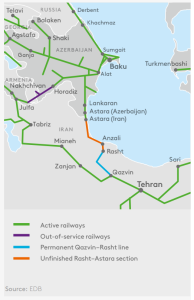
Permitting systems are one of the key mechanisms used to gain access to the international road freight transport market. In the corridor member states, those systems are mostly bilateral and imply individual (for each country pair) conditions governing carrier access, transit operations, etc. Most Eurasian countries currently have no bilateral agreements with India and Pakistan, which prevents direct road freight transport, inflates delivery costs, and causes problems with third-party liability coverage of cargoes and vehicles (EDB, 2022, p. 21). There are limited opportunities for the development of a direct railway service between the Eurasian countries in the “1,520 mm gauge area” and Iran because of the need to resolve the gauge conversion problem by either exchanging freight car bogies or using costly bogies with automated break-of-gauge capability, which is not economically feasible for freight operations (EDB, 2022, p. 21). One possible solution is transhipment of containers from one railway flatcar to another, as is done with China–Europe container trains. Still, different track gauges remain a significant obstacle for transporting other types of cargo, e.g., liquid cargoes, where bogie exchange or car-to-car transhipment is not always possible for safety reasons (EDB, 2022, p. 21).
The incomplete Rasht-Astara railway remains a critical bottleneck, disrupting seamless cargo transit. While parts of the Qazvin-Rasht-Astara railway are operational, key sections remain unfinished, delaying full connectivity (EDB, 2022, p. 21). Iran’s railway system faces low electrification rates, affecting transport efficiency across all INSTC routes. Investments in track electrification, secondary rail development, and rolling stock modernization are necessary to improve cargo flow (EDB, 2022, p. 19).
Ports and Terminals
Seaport and canal limitations, such as sediment accumulation in the Volga-Caspian Sea Shipping Canal, outdated transshipment terminals, and a lack of modern container ships and Ro-Ro vessels, hinder Iran’s maritime capacity (EDB, 2022, p. 19). Uncoordinated customs rules complicate the process of state border crossing by cargo and vehicles. Some border-crossing points lack the “one-window” mechanism and have failed to implement the Transit Guidelines of the World Customs Organisation. Because of that—and also because of the relatively poor infrastructure—it takes carriers a long time to complete customs and other formalities at sea ports and automobile border-crossing points (EDB, 2022, p. 21). Addressing these infrastructure, financial, and geopolitical barriers is critical for Iran to fully leverage the INSTC’s potential as a major Eurasian transport hub. Improving coordination among member states, securing funding for critical infrastructure projects, and resolving logistical bottlenecks will be key to ensuring the INSTC’s long-term viability and competitiveness (EDB, 2022, p. 21).
By addressing these non-physical and infrastructural barriers through investment, policy harmonization, and streamlined customs procedures, the INSTC can significantly improve trade efficiency and enhance its role as a major Eurasian transport corridor.
A Focus on the Development of the Customs and Logistics Infrastructure of the INSTC Corridor
The INSTC has significant trade potential but faces regulatory and logistical inefficiencies. Underdeveloped customs services in Russian ports and infrastructure gaps hinder freight movement. Renewed interest followed Iran’s sanctions relief (2016) and the EEU Customs Code (2018), aligning with Russia’s trade ambitions, particularly in grain exports and partnerships with India and Europe (Ashmarina & Vochozka, 2019). Key infrastructure developments since 1993 include the Turkmenistan-Kazakhstan railway (2013), the Russia-Iran border railway (2014), and the Qazvin-Astara railway trial (2018). Despite progress, economic and political uncertainties impact freight turnover, and customs inefficiencies persist (Ashmarina & Vochozka, 2019).
Customs inefficiencies remain a major bottleneck. The World Bank’s 2016 Logistics Performance Index ranked Russia 116th in international deliveries, Iran 89th, and India 39th. Russia’s customs service ranked 141st out of 160 countries. The EEU Customs Code (2018) introduced automation and improved inter-agency coordination, while Iran reduced transit tariffs by 50% to enhance competitiveness (Ashmarina & Vochozka, 2019). A comprehensive customs and logistics framework is needed to address coordination gaps, inefficient cargo handling, and infrastructure modernization. INSTC must align its logistics network with global trade demands while managing domestic supply chain realities.
State involvement in transport corridor development is well-documented (Kampan, 2017; Tulokhonov, 2017), as is the need for transport modernization in Eurasia (Haghighi et al., 2013; Seo et al., 2017). However, customs integration remains fragmented (Gupanova, 2011; Fedorenko, 2014). INSTC’s success depends on infrastructure completion, unified customs regulations, and expanded trade agreements. A harmonized framework integrating customs processes, logistics, and policy support is essential to attract foreign and domestic enterprises (Ashmarina & Vochozka, 2019). INSTC has the potential to reshape Eurasian trade but requires sustained investment, regulatory harmonization, and logistical improvements. Addressing these challenges will strengthen regional economic integration and enhance INSTC’s role in global trade (Ashmarina & Vochozka, 2019).
Iran’s Geopolitical and Economic Importance
Central Position of Iran in the INSTC
Iran occupies a unique geopolitical position in the INSTC, acting as the central transit hub connecting South Asia, Central Asia, Russia, and Europe. The corridor not only boosts Iran’s economic importance but also plays a vital role in regional trade realignment, allowing Iran to strengthen its economic and diplomatic ties. Additionally, Iran benefits from trade facilitation while bypassing major Western trade routes, reinforcing its role in international logistics and supply chains. Iran is the most critical land bridge within the INSTC, linking the Persian Gulf, Caspian Sea, and Russia with Europe. Goods transported via Iran reach Russia, Northern Europe, and the Baltic states much faster than via the Suez Canal, cutting travel time from 45-60 days to 20-25 days. This corridor may target trade between Russia, the EU, and Central Asia with India, Arab countries, African countries, China, and South-East Asian countries, significantly broadening its economic reach.
Development of Customs and Logistics Infrastructure in the INSTC
The International North-South Transport Corridor (INSTC) serves as both a strategic trade route and a potential avenue for sanctions evasion for Iran and Russia. This corridor enhances Iran’s economic ties with India, Russia, Armenia, Turkmenistan, Azerbaijan, and Central Asia, positioning it as a crucial Eurasian trade hub by linking Central Asia to the Persian Gulf and India to Russia. For India, the INSTC provides a direct trade route to Eurasia, reducing its dependence on Pakistan-controlled trade corridors. While there is potential for Pakistan to connect its Gwadar port with Chabahar and the Belt and Road Initiative (BRI), this has not yet materialized (EDB, 2022, p. 21).
Despite its potential, the INSTC faces significant regulatory and logistical inefficiencies, primarily due to underdeveloped customs services and infrastructure gaps. Russian ports suffer from outdated customs processing, and freight movement is hindered by bureaucratic delays. Although Iran’s sanctions relief in 2016 and the introduction of the Eurasian Economic Union (EEU) Customs Code in 2018 spurred renewed interest in the corridor, progress remains slow due to economic and political uncertainties (Ashmarina & Vochozka, 2019).
Key infrastructure developments supporting the INSTC include the Turkmenistan-Kazakhstan railway (2013), the Russia-Iran border railway (2014), and the Qazvin-Astara railway trial (2018). However, customs inefficiencies persist—as reflected in the 2016 World Bank Logistics Performance Index, where Russia ranked 116th in international deliveries, Iran 89th, and India 39th. Russia’s customs services ranked 141st out of 160 countries, highlighting the need for modernization (Ashmarina & Vochozka, 2019).
A harmonized customs and logistics framework is essential for INSTC’s success. This framework should focus on:
- Customs automation and digitalization to improve efficiency
- Streamlined border crossing procedures to reduce delays
- Infrastructure modernization in Russian and Iranian ports
- Integration of transport policies to ensure uniform standards across member states
Financial Resilience Against Western Sanctions
The International North-South Transport Corridor (INSTC) serves as a strategic trade route for nations like Russia, India, and China, offering a platform to enhance economic ties while mitigating the impact of Western sanctions. A significant development in this context is the shift towards conducting trade in national currencies, reducing reliance on the U.S. dollar (USD) and strengthening financial sovereignty. Russia and India have made notable strides in this direction. As of late 2024, approximately 90% of their bilateral trade is settled in Russian rubles and Indian rupees. This transition has been facilitated by renewed discussions between the Reserve Bank of India (RBI) and the Central Bank of Russia, aiming to establish mechanisms that expand local currency trade and address payment issues arising from increased bilateral commerce. Similarly, Russia and China have deepened their financial cooperation. By the end of 2024, over 90% of trade transactions between the two countries were conducted in rubles and yuan. This significant shift reflects a concerted effort to de-dollarize trade and develop an alternative financial system less susceptible to external economic pressures.
These successful transitions underscore the potential for the INSTC member states to enhance financial resilience by adopting similar strategies. By increasing the use of local currencies in trade settlements, these nations can reduce exposure to USD-centric financial systems and the associated geopolitical risks. This approach not only fosters economic integration among participating countries but also strengthens the overall stability and sustainability of the INSTC as a vital trade corridor. To ensure the long-term resilience of the INSTC against Western sanctions, particularly those imposed by the United States, member nations must establish independent financial mechanisms that function outside the U.S. dollar (USD)-dominated global system. The USD has historically been used as a geopolitical tool, restricting access to international financial networks (Hudson, 2021). To mitigate these vulnerabilities, alternative financial frameworks are necessary:
- Bilateral and Multilateral Banking Agreements – INSTC member states should settle trade using local currencies such as the Chinese Yuan (CNY) and Russian Ruble (RUB), reducing reliance on USD-based transactions (Zhang & Li, 2020).
- Dedicated INSTC Clearinghouse – A centralized payment processing system modeled after the EU’s INSTEX mechanism could facilitate non-USD trade (Jones & Smith, 2022).
- Blockchain-Based Financial Networks – Decentralized blockchain transaction systems could replace SWIFT-based banking, ensuring secure and transparent trade settlements (Kumar & Singh, 2021).
- Expansion of Currency Swap Agreements – Countries like Iran, Russia, and India could expand non-USD trade settlements, reducing exposure to external financial restrictions (Patel & Ghosh, 2023).
- Integration with BRICS Financial Infrastructure – Iran should work with BRICS nations to access non-dollar financial instruments through the New Development Bank (NDB), supporting infrastructure development and trade financing along the INSTC (Xiao & Chen, 2023).
While the INSTC holds immense potential to reshape Eurasian trade, it faces logistical, financial, and regulatory hurdles that must be addressed. Customs inefficiencies, infrastructure gaps, and sanctions-related restrictions have prevented the corridor from achieving its full potential. A comprehensive approach, integrating customs modernization, transport infrastructure development, and financial independence, is crucial to ensure its long-term sustainability. Strengthening these areas will enhance regional economic integration and solidify INSTC’s role as a global trade corridor (EDB, 2022, p. 21; Ashmarina & Vochozka, 2019).
Key INSTC Development Investment Projects for IRAN
Iran has been extensively investing in infrastructure expansion, including port development, railway construction, and highway modernization, to optimize transit efficiency within the INSTC. Iran is expanding its transport infrastructure to optimize transit efficiency within the INSTC. Key projects focus on port development, railway expansion, and highway modernization, reinforcing Iran’s role as a strategic transit hub.
— Iranian Ports in the INSTC
Iran’s ports are vital for INSTC freight movement, serving as primary entry/exit points for goods transiting between India, Russia, Europe, and Central Asia:
- Bandar Abbas (Persian Gulf) – The largest container port in Iran, serving as the key hub for Indian cargo destined for Russia and Europe. The port is further strengthened by the new Bulk Cargo Terminal at Shahid Rajaee (EDB, 2022, p. 19).
- Chabahar Port – India has invested $85 million to develop Chabahar as an alternative trade route bypassing Pakistan. Iran is also constructing a new port in Chabahar, enhancing its role as a transshipment hub for South Asian and Central Asian trade (EDB, 2022, p. 19).
- Bandar-e Anzali & Amirabad (Caspian Sea) – Crucial for Iran-Russia maritime trade, these ports facilitate freight movement between the Caspian region, Russia, and Eurasian markets.
- Imam Khomeini Port (BIK) – While Bandar Abbas and Chabahar receive much attention, BIK offers direct highway access to Tehran, enhancing its role as a key logistics hub. The Bazargan–BIK motorway will improve connectivity between Iran and Turkey, supporting overland trade routes (EDB, 2022, p. 19).
— Iran’s Railway Expansion for INSTC
Iran is investing heavily in railway infrastructure to enhance connectivity and eliminate bottlenecks along the INSTC:
- Rasht–Astara Railway – A critical missing link, its completion will enable seamless cargo transit between Iran, Azerbaijan, and Russia (EDB, 2022, p. 21).
- Qazvin–Qom Railway – Supports North-South freight movement, linking Iran’s industrial centers to INSTC trade corridors.
- Qom–Bafq–Kerman–Zahedan Railway Modernization – Strengthening Iran’s eastern transit corridor, improving connectivity between the Persian Gulf, Central Asia, and Afghanistan.
- Zahedan–Birjand Railway – New construction enhancing rail access to eastern Iran and beyond.
- Chabahar–Faraj–Bam Railway – Establishing a direct rail connection from Chabahar to Iran’s main freight network, facilitating transit between South Asia and Central Asia.
- Garmsar–Incheh Borun Railway Modernization – Strengthens Iran-Turkmenistan railway links, improving connectivity with Central Asia.
— Iran’s Road and Highway Modernization
Iran is developing major motorways to support INSTC freight movement:
- Tabriz–Marand–Bazargan Motorway – Enhancing Iran-Turkey trade via the Bazargan border crossing, a key entry point for European and Middle Eastern markets.
- Bazargan–Imam Khomeini Port Motorway – A strategic east-west corridor connecting Iran’s Caspian region to the Persian Gulf, optimizing internal freight distribution.
- Sirjan–Bandar Abbas Road – A critical southern highway project facilitating container transport to Bandar Abbas, Iran’s most significant international port.
These ongoing and planned investments will solidify Iran’s role as the backbone of the INSTC trade corridor, enhancing rail, road, and port connectivity while reducing transit bottlenecks and expanding regional trade capacity.
–
While many research studies focus on Azerbaijan as the main route in the INSTC, alternative pathways such as Turkmenistan, Armenia, and direct Caspian Sea routes (between Russia and Iran) are equally significant. These routes facilitate large-volume transport, provide access to additional markets, and prevent over-reliance on Azerbaijan, which could otherwise leverage its strategic position against both Iran and Russia. The INSTC is a major economic driver for Iran, enabling revenue generation through trade tariffs, logistics services, and transit fees. This section discusses how Iran’s participation in the corridor can diversify its economy, strengthen key partnerships, and increase its financial leverage within Eurasian trade routes.
The INSTC as an Energy Corridor: Elevating Iran to an Energy Hub
The International North-South Transport Corridor (INSTC) holds significant potential to transform Iran into a central energy hub, facilitating the efficient transit of energy commodities such as natural gas, oil, and fertilizers. This strategic role is underscored by Russia’s position as one of the world’s leading producers of natural gas and fertilizers.
Russia’s Dominance in Energy and Fertilizer Production
Russia is a global leader in natural gas production, with companies like Gazprom significantly increasing output. In 2024, Gazprom’s gas production rose to approximately 416 billion cubic meters, marking a substantial recovery from previous declines (reuters.com). In the fertilizer sector, Russia plays a crucial role, accounting for 16% of global urea exports and 12% of phosphate exports. This substantial share underscores Russia’s influence in the global fertilizer market (ers.usda.gov).
To capitalize on the INSTC’s potential as an energy corridor, it is imperative to develop and optimize existing infrastructure between Iran and Russia. Key initiatives include:
- Pipeline Development: Constructing new pipelines and upgrading existing ones to facilitate the seamless flow of natural gas and oil between Russia and Iran. This includes addressing technical challenges and ensuring compliance with international standards.
- Port Modernization: Upgrading Iranian ports such as Bandar Abbas and Bandar Khomeini to handle increased volumes of energy commodities. This involves enhancing loading and unloading facilities, storage capacities, and implementing advanced logistics systems.
- Railway Connectivity: Completing critical railway projects like the Rasht-Astara line to ensure efficient land-based transportation of energy products. This railway is a vital segment of the INSTC, connecting Iran and Azerbaijan, and plays a significant role in facilitating trade and transit in the region (en.wikipedia.org).
Iran enhances its geopolitical standing by serving as a central node in the INSTC and plays a pivotal role in regional energy dynamics. The corridor offers an alternative route for energy exports, reducing dependence on traditional pathways and contributing to the diversification of energy supply chains. This diversification is particularly pertinent in the context of shifting geopolitical alliances and the need for resilient energy infrastructure.
The INSTC as a Grain and Cereals Corridor: Elevating Iran to a Grain and Cereals Hub
The INSTC’s strategic design significantly enhances the efficiency of grain and fertilizer transit, positioning Iran as a pivotal hub in the global agricultural supply chain. Iran’s geographic advantage and developed port infrastructure facilitate the seamless movement of commodities such as wheat, rice, other cereals, and fertilizers between major producing and consuming nations.
Establishment of Grain and Fertilizer Hubs in Iranian Ports
Plans are underway to establish Russian grain transport hubs in Iranian ports, notably Bandar Abbas or Bandar Khomeini. These hubs are envisioned to streamline the export process, allowing for the efficient aggregation and distribution of grain shipments to various destinations, including markets in Africa and the Middle East(en.wikipedia.org). Similarly, establishing fertilizer distribution centers in these ports can facilitate the efficient transit of Russian fertilizers to global markets. Given Russia’s significant role in the fertilizer industry, such hubs would enhance supply chain efficiency and meet the agricultural needs of importing countries. The integration of Iranian ports into the INSTC enhances connectivity for agricultural commodities and inputs. For instance, the port of Astara, inaugurated in March 2013, has been integrated into the INSTC to improve maritime connectivity across the Caspian Sea. This port allows for faster and more cost-effective transportation of Russian goods, including grains and fertilizers, to inland provinces of Iran and onward to international markets(en.wikipedia.org) By facilitating the efficient transit of grains and fertilizers, Iran contributes to regional food security and agricultural productivity. The streamlined movement of these essential commodities helps stabilize supply chains, reduce transit times, and lower transportation costs, thereby ensuring that importing nations have reliable access to staple foods and necessary agricultural inputs. Serving as a transit hub for grains and fertilizers brings significant economic benefits to Iran. The country stands to gain from transit fees, port duties, and related services, bolstering its economy and reinforcing its strategic importance in regional trade networks.
The INSTC as a Cultural Corridor: Fostering Cultural Connectivity and Bridging Between Societies
The International North-South Transport Corridor (INSTC) transcends its primary economic and logistical functions, emerging as a vital cultural corridor that fosters connectivity and mutual understanding among nations such as India, Iran, Russia, and Central Asia. By facilitating the movement of people, ideas, and cultural practices, the INSTC enriches the social fabric of the region and promotes societal integration.
Tourism Development Along the Corridor
Enhanced connectivity through the INSTC significantly boosts tourism by making travel between member countries more accessible. Improved transportation links encourage tourists to explore diverse cultural and historical sites, fostering mutual appreciation among the region’s populations. This increase in tourism not only stimulates local economies but also strengthens cross-cultural bonds.
Cultural Exchange and Mutual Understanding
The INSTC serves as a conduit for cultural exchange, enabling educational programs, artistic collaborations, and cultural festivals. Such initiatives allow societies to share their heritage and traditions, contributing to greater mutual understanding and regional cohesion. For instance, the Intra Asia Network (IAN) exemplifies how cultural workers and creative spaces collaborate across borders to promote artistic mobility and community engagement.
Societal Connectivity and Regional Integration
By linking diverse societies, the INSTC fosters a sense of regional integration. Communities along the corridor can engage in dialogue, share best practices, and collaborate on common challenges. This societal connectivity lays the groundwork for a more integrated and harmonious region. The inclusion of countries like Pakistan in the INSTC can further enhance regional connectivity and economic integration, serving as a gateway between South Asia, the Middle East, and Central Asia. This expansion would not only advance national interests but also facilitate cultural exchange, boost trade, and attract investments, thereby promoting regional stability.
Learning from Global Best Practices
Drawing inspiration from successful international transport corridors can provide valuable insights for the INSTC:
-
Educational and Research Collaborations: The Belt and Road Initiative (BRI) emphasizes educational cooperation through mutual recognition of qualifications, academic mobility, and joint research programs. Implementing similar strategies within the INSTC can enhance academic exchanges and research partnerships. en.wikipedia.org
-
Cultural and Artistic Festivals: Organizing joint art exhibitions, film festivals, and cultural events can celebrate the region’s rich heritage. Such initiatives promote cross-cultural understanding and showcase the diverse traditions of member countries.
-
Sports Competitions: Establishing regional sports tournaments can unite communities and foster a spirit of camaraderie. Sports events serve as a platform for cultural exchange and strengthen interpersonal connections across borders.
-
Harmonization of Policies: Aligning policies related to driver licensing, visa regulations, and educational qualifications can facilitate smoother cross-border interactions. For example, coordinated legal frameworks have been pivotal in enhancing cross-border mobility within the European Union’s transport corridors. transport.ec.europa.eu
-
Digitalization and Information Sharing: Developing digital platforms for information exchange can streamline logistics and enhance transparency. The Regional Conference on Transport Corridors and Health 2024 highlighted the role of digitalization in improving transport efficiency and fostering cultural exchanges. northstar-alliance.org
Establishing a Permanent Institutional Framework
For the long-term success of the INSTC as a cultural corridor, establishing a permanent institution dedicated to promoting inter-regional cooperation is essential. This body would oversee the harmonization of policies, coordination of cultural and educational programs, and the digitalization of processes to ensure seamless interactions among member countries. Such an institution would act as a catalyst for sustained cultural exchange and mutual understanding, reinforcing the INSTC’s role beyond mere trade and transport. In conclusion, by integrating these multifaceted societal activities and learning from global best practices, the INSTC can evolve into a dynamic cultural corridor. This evolution will not only enhance economic ties but also strengthen the cultural and social fabric of the region, fostering a more connected and harmonious Eurasian community.
Pakistan’s inclusion in the International North-South Transport Corridor (INSTC)?
Pakistan’s entry into the International North-South Transport Corridor (INSTC), confirmed on June 19, 2024, enhances regional trade and connectivity. Integrated with the China-Pakistan Economic Corridor (CPEC) under the Belt and Road Initiative (BRI), Gwadar Port boosts China’s access to Central Asia and global markets. Meanwhile, India’s Chabahar Port serves as a competing trade hub linking Central Asia, Russia, and Northern Europe. INSTC’s 7,200-kilometer multimodal network reduces transit times and costs, strengthening Pakistan as a transit gateway between Central and South Asia. Its alignment with energy projects like TAPI adds to its strategic value. Iran’s expansion of Chabahar, led by Bashir Gonbadi, highlights regional trade ambitions, and Pakistan’s collaboration with Iran and China could enhance economic synergies. Despite security and logistical challenges, integrating INSTC with Iranian transport routes could link Chabahar and Gwadar, reinforcing both ports’ strategic significance. With regional cooperation and infrastructure investments, Pakistan stands to maximize its economic and geopolitical gains.
If Pakistan truly intends to integrate into the INSTC and use the Iranian transport routes, it could benefit Iran by establishing a vital link between Chabahar and Gwadar, fostering economic synergies, promoting regional stability, and providing Chabahar port with growth opportunities.
Future Prospects & Strategic Outlook
Iran’s pivotal role in the INSTC continues to evolve as it expands infrastructure, strengthens trade alliances, and enhances logistical capabilities. Despite persistent challenges, Iran’s investments in transport modernization and diplomatic engagements are positioning it as a key transit hub in Eurasian trade.
- Completion of Rasht-Astara Railway: Expected by 2025-2026, this railway will bridge a crucial gap in INSTC, facilitating seamless cargo movement between Iran, Azerbaijan, and Russia. A fully operational INSTC could triple freight traffic by 2030, boosting Iran’s transit revenue and trade influence.
- Full Membership in the Eurasian Economic Union (EAEU): Iran is currently not a full member of the EAEU but has signed a free trade agreement with the bloc. The agreement is set to expand market access, ease tariff restrictions, and enhance cross-border trade efficiency. This integration is expected to position Iran as a gateway for Russia and Central Asian economies to access South Asia and the Persian Gulf markets.
- Digitalization & Trade Facilitation: Iran is modernizing customs procedures by adopting digital tracking, blockchain-based trade settlements, and e-transit systems. Implementing the TIR Convention will significantly cut transit times, reduce trade bottlenecks, and improve INSTC’s competitiveness against alternative corridors.
- Expansion of Chabahar Port & Maritime Connectivity: India’s investments in Chabahar aim to transform it into a regional trade hub, strengthening Iran’s role as a strategic link between South Asia, Central Asia, and Europe. Furthermore, expanding Iran’s Caspian ports, such as Bandar-e Anzali, will enhance maritime connectivity with Russia and Central Asia.
- Geopolitical and Economic Positioning: Iran is leveraging its strategic location to become a dominant transit corridor, countering Western-backed alternatives like TRACECA and IMEC. Diversifying trade partners and fostering financial independence through non-USD transactions, bilateral banking mechanisms, and BRICS cooperation will enhance Iran’s resilience against Western sanctions.
Iran’s success in the INSTC will hinge on overcoming sanctions, securing alternative financing, and enhancing multimodal infrastructure. By integrating land, rail, and maritime networks, Iran can transform into a major logistics powerhouse, shaping the future of Eurasian trade and reinforcing its strategic and economic influence on global commerce.
 Most Frequently Asked Questions (FAQ) & Keywords about the INSTC Corridor
Most Frequently Asked Questions (FAQ) & Keywords about the INSTC Corridor
1. What is the International North-South Transport Corridor (INSTC)?
The INSTC is a 7,200-km-long multimodal trade route that connects India, Iran, Russia, and Europe through a combination of sea, rail, and road. It aims to make international trade faster, cheaper, and more efficient, especially between South Asia and Northern Europe.
2. When was the INSTC officially launched?
The corridor was formally established in 2000 through a trilateral agreement signed by India, Iran, and Russia at the Euro-Asian Conference on Transport.
3. What are the main objectives of the INSTC?
-
Reduce freight costs by up to 30%
-
Cut transit time by 40% compared to traditional routes like the Suez Canal
-
Strengthen Eurasian trade integration
-
Offer alternative routes that avoid chokepoints and political constraints
4. Which countries are part of the INSTC?
There are 13 member countries:
India, Iran, Russia, Azerbaijan, Armenia, Belarus, Kazakhstan, Kyrgyzstan, Tajikistan, Oman, Turkey, Syria, and Ukraine.
5. Why is the INSTC important for India?
-
Offers a cost-effective and shorter route to Europe and Central Asia
-
Increases connectivity with Afghanistan and bypasses Pakistan
-
Supports India’s multi-alignment strategy
-
Counters China’s Belt and Road Initiative (BRI)
-
Boosts exports via Chabahar Port in Iran
6. What are the key challenges facing the INSTC?
-
Geopolitical tensions (e.g., Russia-Ukraine conflict, Iran sanctions)
-
Incomplete infrastructure in certain regions
-
Customs and regulatory bottlenecks
-
Need for greater digitization and standardization across borders
7. How is INSTC different from the Suez Canal Route or BRI?
-
It’s shorter and cheaper than the Suez Canal route
-
Uses multi-modal connectivity rather than sea-only transport
-
Encourages regional trade autonomy instead of dependency on global chokepoints
-
Seen as a non-China-centric trade initiative, unlike the BRI
8. Is the INSTC fully operational today?
While several segments are already functional (notably India-Iran-Russia via Chabahar and the Caspian Sea), full-scale implementation is still underway, with active infrastructure development and pilot shipments already completed.
 Related Keywords People Search:
Related Keywords People Search:
INSTC corridor route, INSTC countries, Chabahar Port INSTC, India Iran Russia trade, INSTC vs BRI, INSTC Suez Canal alternative, INSTC UPSC notes, North-South corridor benefits, INSTC map, INSTC logistics
 Most Helpful Links & Resources to Learn More about the INSTC Corridor
Most Helpful Links & Resources to Learn More about the INSTC Corridor
-
Testbook – Comprehensive Overview of INSTC
A go-to guide for aspirants and learners covering route map, benefits, challenges, and current developments. Great for UPSC & general studies. -
NEXT IAS – Editorial Analysis of INSTC
Detailed editorial on the strategic and economic implications of the corridor. Especially useful for policy students and analysts. -
SSB Crack – All About INSTC
Covers the operational framework, significance of Chabahar Port, and how INSTC fits into India’s strategic ambitions. -
ForumIAS Blog – Strategic Value of INSTC for India
Breaks down India’s multi-alignment strategy, why INSTC matters to foreign policy, and how it compares to other global corridors. -
ClearIAS Video Lecture on INSTC (YouTube)
A visual, beginner-friendly video explanation of the corridor, especially effective for concept clarity and revision.
By R.Karimpour
——————————————————————————————————————————————————————————————–
References
Ashmarina, S., & Vochozka, M. (Eds.). (2019). Sustainable growth and development of economic systems: Contradictions in the era of digitalization and globalization. Springer. https://doi.org/10.1007/978-3-030-11754-2
Ashmarina, S., & Vochozka, M. (Eds.). (2019). Sustainable Growth and Development of Economic Systems: Contradictions in the Era of Digitalization and Globalization. Contributions to Economics. Springer Nature Switzerland AG.
Drewello, H., Scholl, B. (eds.): Integrated Spatial and Transport Infrastructure Development: The Case of the European North-South Corridor Rotterdam-Genoa, Springer Series: Contributions to Economics, pp. 1–328 (2015)
Economy profile: Azerbaijan (2018). http://www.doingbusiness.org/data/exploreeconomies/azerbaijan. Last accessed 29 Mar 2018
Economy profile: Iran, Islamic Republic (2018). http://www.doingbusiness.org/data/exploreeconomies/iran. Last accessed 29 Mar 2018
Economy profile: Russian Federation (2018). http://www.doingbusiness.org/data/exploreeconomies/russia. Last accessed 29 Mar 2018
EDB. (2022). INSTC Development Report. Eurasian Development Bank.Fedorenko, R.V.: Development of outsourcing in the customs sphere. Asian Soc. Sci. 10(20), 202 209 (2014)
Hudson, M. (2021). Super Imperialism: The Economic Strategy of American Empire. Pluto Press.
Jones, R., & Smith, P. (2022). INSTEX: Europe’s Response to US Sanctions on Iran. International Journal of Political Economy, 51(3), 97-113.
Kampan, P.: Strategic development of ASEAN logistics infrastructure. Open Transp. J. 11,67–80 (2017)
Khalova, G. O., Illeritskiy, N. I., Rakhimov, A. R., Rozhko, O. N., Khalov, O. M., & Li, S. (2024). Implementation of projects of international transport corridors on the Eurasian continent as drivers of economic growth of the region. Journal of Infrastructure, Policy and Development, 8(5), 3624. https://doi.org/10.24294/jipd.v8i5.3624
Khobragade, V., & Nim, A. K. (2022). International North-South Transport Corridor: Mapping Vulnerabilities and Possibilities for India. World Affairs: The Journal of International Issues, 26(3), 40-53. https://www.jstor.org/stable/10.2307/48712324
Kryukova, E. V. (2020). Concept for the development of the North-South International Transport Corridor. Journal of Volgograd State University. Economics, 22(2), 141-147. https://doi.org/10.15688/ek.jvolsu.2020.2.13
Kumar, A., & Singh, R. (2021). Blockchain for International Trade: A Future Without SWIFT?. Journal of Financial Innovation, 10(2), 45-60.
Liao, R.: Supernetwork-based risk management of customs logistics monitoring system. Complex Syst. Complex. Sci. 14(2), 39–45 (2017)
Modern Issues of Development of the Customs
Gupanova, Y.E.: Actual problems of customs services’ quality management problems. J. Russ. Cust. Acad. 1,5–12 (2011) Haghighi, M., Hassangholi Pour, T., Khodadad Hossani, H., Yousefi, H.: Development of container transit from the Iranian South ports with a focus on the international North-South transport corridor. In: Marine Navigation and Safety of Sea Transportation: Maritime Transport and Shipping, pp. 187–193 (2013)
Otsuka, N., Günther, F.C., Tosoni, I., Braun, C.: Developing trans-European railway corridors: lessons from the Rhine-Alpine corridor. Case Stud. Trans. Policy 5(4), 527–536 (2017)
Patel, S., & Ghosh, D. (2023). Currency Swap Agreements: A Mechanism for De-Dollarization in Global Trade. Asian Economic Review, 28(1), 76-89.
Šakalys, R., Batarliene, N.: Research on intermodal terminal interaction in international transport corridors. Proc. Eng. 187, 281–288 (2017)
Seo, Y.J., Chen, F., Roh, S.Y.: Multimodal transportation: the case of laptop from Chongqing in China to Rotterdam in Europe. Asian J. Shipp. Logist. 33(3), 155–165 (2017)
Tulokhonov, A.K.: Directions, conditions, and risks of implementation of the transport mega-projects “North-South” and “East-West” under the new geopolitical realities. Geogr.
Environ. Sustain. 10(1), 70–77 (2017)
Ullah, N., & Brohi, M. A. (2018). International North-South Transport Corridor: Challenges and Opportunities for Pakistan. Stratagem, 1(1), 100-102.
Ullah, N., & Brohi, M. A. (2018). International North-South Transport Corridor: Challenges and Opportunities for Pakistan. Stratagem, 1(1), 100–113.
Vinokurov, E. (Ed.), Ahunbaev, A., Usmanov, N., & Zaboev, A. (2022). International North–South Transport Corridor: Investments and Soft Infrastructure. Eurasian Development Bank. Available at SSRN: https://ssrn.com/abstract=4260798
Vinokurov, E. Y., Ahunbaev, A., & Zaboev, A. I. (2022). International North–South Transport Corridor: Boosting Russia’s “pivot to the South” and Trans-Eurasian connectivity. Russian Journal of Economics, 8(2022), 159-173. https://doi.org/10.32609/j.ruje.8.86617
Vinokurov, E., Ahunbaev, A., Usmanov, N., & Zaboev, A. (2022). International North-South Transport Corridor: Investments and Soft Infrastructure. Eurasian Development Bank. https://eabr.org/en/analytics/special-reports/
Vinokurov, E. (Ed.), Ahunbaev, A., Usmanov, N., & Zaboev, A. (2022). International North–South Transport Corridor: Investments and soft infrastructure (Reports and Working Papers No. 22/2). Eurasian Development Bank.
World Bank Logistics Performance Index Global Rankings (2016). http://www.lpi.worldbank.org/international/global/2016. Last accessed 01 Apr 2018
World Bank: Doing Business: Understanding Regulations for Small and Medium-Size Enterprises.
World Bank: Doing Business: Understanding Regulations for Small and Medium-Size Enterprises.
World Bank: Doing Business: Understanding Regulations for Small and Medium-Size Enterprises.
Economy profile: India (2018). http://www.doingbusiness.org/data/exploreeconomies/india.Last accessed 29 Mar 2018
World Bank: Doing Business: Understanding Regulations for Small and Medium-Size Enterprises.
Xiao, Y., & Chen, L. (2023). The Role of BRICS in Global Financial Realignment: A Study of NDB Initiatives. BRICS Economic Review, 14(2), 121-138.
Zhang, W., & Li, H. (2020). Yuan Internationalization and Its Implications for Global Trade Settlements. Journal of Global Economics, 27(4), 211-235.

